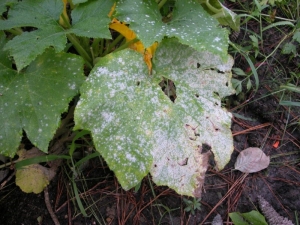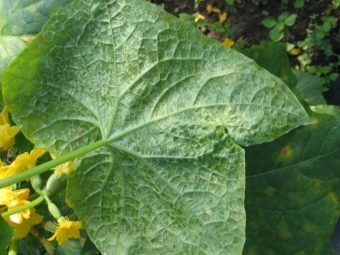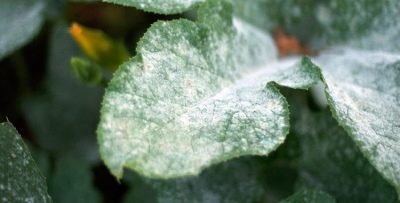Mealy dew on cucumbers: a description of the disease and methods of treatment

It is difficult now to find a summer cottage on which at least a few cucumber bushes would not be planted - after all, this vegetable is good both raw and preserved, and for preparing various dishes such as salads, rolls and okroshka. In order to get an acceptable yield of these fruits, it is important to properly care for the beds, including the prevention and treatment of various diseases typical for this crop. Therefore, it is worth considering the description and varieties of such a dangerous disease, like powdery mildew on cucumbers, as well as various methods of its treatment.
Characteristic
In general, powdery mildew is a disease of vegetables and fruits, the causative agents of which are various parasitic fungi. Outwardly, this disease usually manifests itself in the form of spots that gradually appear and grow on the leaves, branches and fruits of the affected plant, which eventually become covered with small droplets. As it develops, the disease completely affects the plant, leading primarily to drying or rotting of the fruit. The powdery mildew left without treatment rapidly spreads to neighboring plants and can potentially destroy the whole bed.
Despite the unity of symptoms and consequences, different fungal pathogens cause powdery mildew for different species. For cucumbers, depending on the type of fungus that led to the disease, there are two types of powdery mildew - the real one, usually caused by the fungus Oidium erysiphoides, and false, which is most often caused by another fungus (more precisely, pseudogrib) - Pseudoperonospora cubensis Rostowz. A false version of the disease is also called perinospora. Consider the differences between these diseases more
The real
The mealy dew present on cucumbers at the very beginning of its development looks like small round white specks on the upper side of the leaves.
An unmistakable symptom that allows you to immediately make a diagnosis - the presence of a faint whitish on the lower side of the leaves at the same time as the spots on top. If you do not take operational measures, then over time these spots will merge with each other, and their color will become darker. As a result of the growth of spots, which actually represent the mycelium (mycelium) of the pathogen, the leaves gradually deform, acquire a wavy shape, and then begin to dry out.
Directly, cucumber fruits, unlike many other cultures, are not affected by powdery mildew, but the gradual withering of leaves and shoots leads to a deterioration in the supply of water to fruits and necessary substances, as a result of which their development stops. At first, the individual fruits of the affected plant wither, then the whole branches, and finally the bush dies completely. Yield losses in the event of the spread of this disease in a garden or in a greenhouse can reach 70%. In addition to Oidium erysiphoides, other parasitic fungi, Erysiphe communis and Sphaerotheca fuliginea, can cause a disease with the same picture.
False
Another variation of the powdery mildew of cucumbers - false - initially represents rather large angular spots on the upper surface of the leaves. In contrast to the “real” version of the disease, the color of these spots is usually yellow or even yellow-green.
Within a few days after the appearance of spots on the back of the affected leaves, a grayish bloom appears, caused by the onset of spore formation. As the disease develops, the spots on the leaves grow and merge with each other, and the color becomes darker. Within a week after the first signs of the disease, the drying of the affected leaves gradually develops. After that, the plant can die completely in just three days.
Like true powdery mildew, neglected peronosporoz leads to a significant reduction or even complete loss of the crop. The latter option is even more likely, given the faster death of the affected bushes compared with the case of powdery mildew.
Causes of
Like any infection, powdery mildew in cucumbers occurs as a result of infecting a healthy plant with the spores of a fungus-pathogen. And these disputes appear from infected plants, where the development of the disease has already reached the stage of sporulation. In this case, disputes are best formed in the following conditions:
- good light;
- air temperature is above + 16 ° С;
- low humidity.
Ripening on the infected leaves in special bags called conidia, the spores are then spread through the neighborhood with the help of wind, rain, birds and insects.
In this case, the source of infection of cucumbers does not necessarily have to be other cucumber bushes. Plantain, sow thistle and some other weeds can be used as an intermediate carrier for Oidium erysiphoides. In addition, this disease is well developed on most domesticated members of the pumpkin family, including watermelons, zucchini, melons and pumpkins.
It is not surprising that the bushes that are closest to the windows, doors and other points of contact with open air are the first to be hit in the greenhouses.
In addition to airborne transmission, another method of infection is infection by spores, which were wintered on the uncleared remnants of past plantings or left in the soil after previous crops.
The following factors can also contribute to the rapid development and spread of infection in the garden:
- a wide range of daily temperature fluctuations, which leads to a decrease in plant immunity;
- high rainfall;
- violation of the recommended landing pattern (too close to the bushes);
- a large number of weeds in the neighborhood;
- non-compliance with the rules of crop rotation;
- insufficient pause between the collection of the autumn and the planting of the winter-spring culture;
- low light, which also reduces the immunity of cucumbers, not allowing them to effectively deal with the pathogen;
- phosphorus and potassium deficiency or excessive nitrogen in the soil.
Somewhat different is the development of the false form of the disease. Pseudoperonospora cubensis forms spores that are not usual for fungi, but the so-called zoospores are rather large cells with flagella capable of independent movement in liquids. Therefore, the transfer of downy mildew through the air is extremely limited, and infection through water and soil is the main route of infection. At the same time, like the present form of the disease, peronosporosis develops well not only on cucumbers, but also on most plants of the pumpkin family.
The development of the disease is mainly promoted by the same factors as for the present variant of the disease. Additionally, high humidity and low night-time air temperatures help the spread of the pathogen when a condensate teeming with zoospores forms on the surface of the leaves of infected plants.
This disease is especially rapidly spreading inside greenhouses.
Control measures
At the first symptoms of both diseases, it is worthwhile to temporarily suspend the watering and feeding of infected beds - after all, the spores of a real disease, and the zoospores of the false version are well tolerated by water drops when watering. After this, it is necessary to immediately start treating already afflicted bushes and protecting neighboring healthy plants.
Both the powdery mildew of cucumbers and its false variety have been known for a long time by both summer residents and agronomists of large farms. Not surprisingly, many methods have been developed to combat this dangerous disease. At the same time, along with chemical and biological methods, there are many proven folk remedies that help fight the fungus causing the disease.
Consider the methods that are successfully used to combat the powdery mildew of cucumbers.
Chemical and biological products
Usually they are the most effective for combating this disease, they give results faster than folk remedies, and they can also help to save even plants with very advanced cases of the disease. It is better to start treatment in the early stages of infection with biological preparations, since they are much less harmful to plants and the environment. In the early stages of the disease, it can be defeated with the help of bacterial agents.
A tool such as "Albit", not only helps get rid of the disease, but also protects the bushes from re-infection. In addition, "Albit" strengthens the immunity of cucumbers, helps them to overcome the harmful effects of the use of chemicals and accelerates the growth of new shoots and roots.
If you spray the infected beds with another biological tool - “Alirin-B”, then in addition to the therapeutic effect, the correct microbiological composition of the soil will also be restored. In this case, you can add ordinary soap to the product - then the resulting solution will be better kept on the surface of the treated bushes.
Finally, a remedy such as “Gamar” combines the beneficial effects of the two previous remedies - it heals powdery mildew, boosts plant immunity, stimulates their growth and restores soil composition.
Such a remedy as Baktofit destroys the disease most quickly, but after its use it may be necessary to wash the treated fruit.
The main disadvantage of biological processing means is the need for their repeated use.
Chemicals are used when the disease has already gone quite far. It is possible to apply them both on an open ground, and in the greenhouse. Do not forget to use protective equipment - respirator and thick clothing that covers the whole body. It is usually sufficient to treat the infected area with a chemical fungicide once. These include, for example, "Bayleton." Its use will not only destroy the spores and mycelium of the powdery mildew pathogen, but also protect the bushes from re-infection for up to a month.
Another effective chemical is Topaz. Its effect is slightly weaker - cucumbers will be protected for two weeks.
Drugs like Tiovit-Jet and Rayok are also quite effective for quickly treating a disease. But protection from infection after them lasts only for a week.
Good result shows the use of colloidal sulfur. Just keep in mind that when processing open beds, the concentration of the solution should be 20%, and the use of the drug in the greenhouse will require a twofold increase in concentration.
Folk remedies
Treatment with folk remedies is less effective than even biological ones, but they are cheaper and do not require a long search for the right drug for sale.
Apply these methods usually need every day for a week. For example, you can defeat the fungus by spraying the usual kefir, and even overdue. Instead of kefir, they use sour milk. Another effective method is spraying a solution of manure in water with a concentration of 10%.
Spraying with nettle extract or a solution of soda and laundry soap in water will also help fight the disease. Thus it is necessary to observe the following proportions:
- 100 g of soda;
- 100 g of soap;
- 20 liters of water.
Treatment of peronosporoza
Bordeaux liquid, polycarbacin, chloric acid copper, Quadris, Strobe and Ridomil Gold can additionally help in the treatment of a false version of the disease. The use of Ephal, which can defeat even those populations of fungi that have developed resistance to other chemical fungicides, shows a very high efficiency.
It is necessary to use chemical means no more than two times with an interval of not less than five days (and preferably a week).
Of the biological drugs against peronosporosis, Trichodermin has established itself well.
Folk remedies can act as additional, however, in the case of a false version of the disease, it is important to quickly use effective chemicals, as its development and death of plants occurs several times faster than in the case of infection with powdery mildew.
Prevention
Just to beat the disease for a good harvest is not enough - you need to still protect the plant from its re-occurrence. And best of all, in general, prevent the occurrence of infection initially. Various preventive means and measures will help in this.
First of all, it is necessary to follow the rules of crop rotation - never cucumbers should be planted in the ground in which plants of the pumpkin family grew before. It is unacceptable and re-planting cucumbers in the same bed. In greenhouses, topsoil should be regularly changed.
It is necessary to take into account the possibility of initial infection of seeds with spores of both types of the disease. That is why most gardeners recommend soaking the seeds in a solution of potassium permanganate or in highly diluted fungicides before planting.
Before planting seeds in open ground, it is necessary to remove the remnants of previous crops from its surface - spores of fungi may overwinter in them. After that, you can fill the planned bed with boiling water or a solution of potassium permanganate - this will kill not only fungal spores, but also hibernating insect pest larvae.
It is important to observe the sowing pattern - too dense planting contributes to the rapid spread of the disease to neighboring bushes. Regular weeding is no less important in order to rule out the possibility of the development of fungi on neighboring weeds.
Water cucumbers need only warm water, the temperature of which should be about + 20 ° C. If possible, it is better to use melted or purified water for irrigation.
To prevent the possibility of infection of the leaf surface in the breeding season of pathogens (in early spring for this and at the end of summer for downy mildew), bushes should be sprayed with whey or sodium silicate. And to prevent infection with downy mildew, it is worthwhile to additionally cover the bushes with agrofilm for the night at the end of August.
When cucumbers are grown in greenhouses, care must be taken to ensure that no significant fluctuations in air temperature occur. The average daily range of its values should be in the range from +17 to + 30 ° C.
An effective method for the prevention of powdery mildew is the choice of a variety of planted cucumbers that will be resistant to this disease. Usually these varieties are hybrid, which can be distinguished from the usual ones by the designation “F1” in the title.
In the next video you are waiting for excellent products from powdery mildew.





































